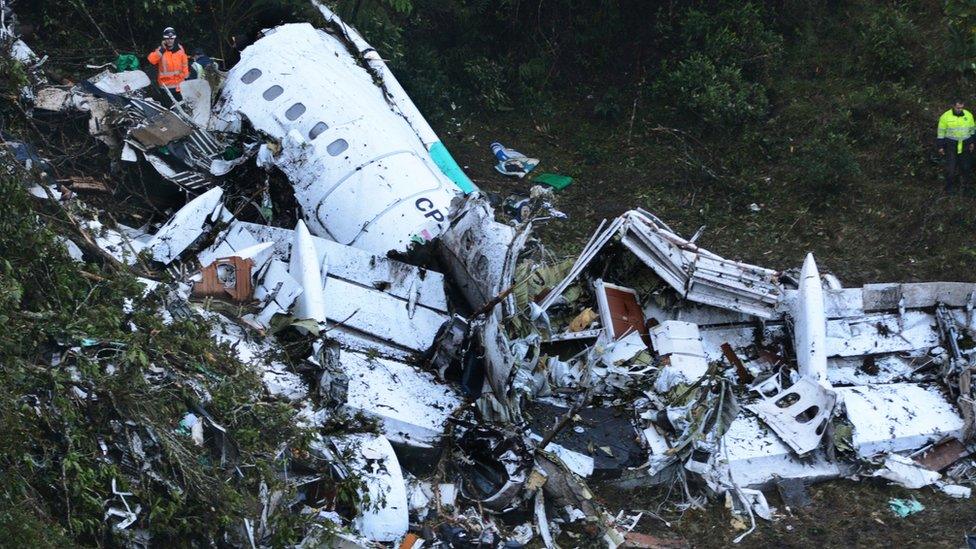Colombia Chapecoense plane crash: What we know
- Published
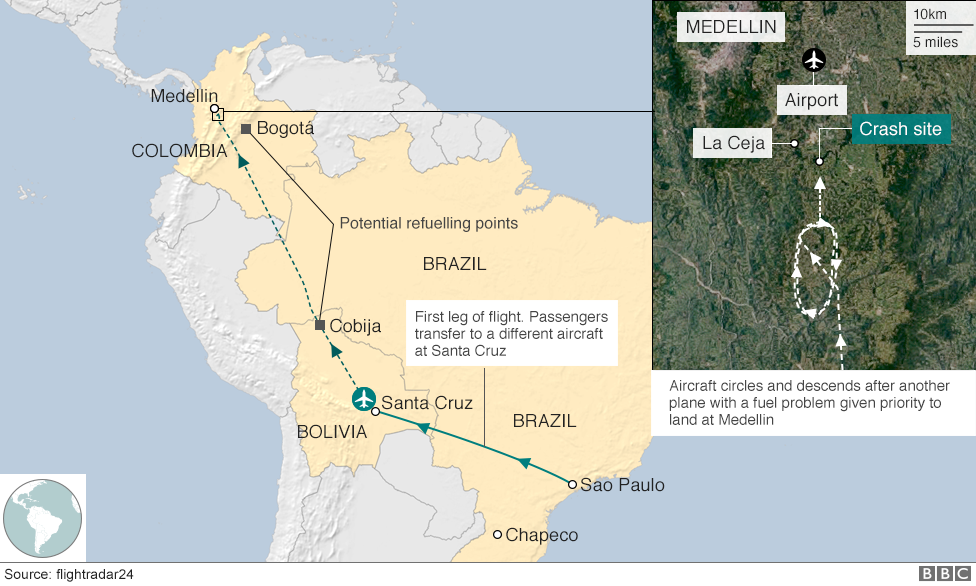
Investigators are trying to work out why the plane that crashed in Colombia on 28 November, killing 71 people, ran out of fuel. The dead include most of Brazil's Chapecoense football club. Six people survived. Here is what we know so far.
What happened?
The plane, operated by Bolivian-based charter airline Lamia, was flying from Santa Cruz de la Sierra, in Bolivia, to Medellin, in Colombia.
It lost contact with ground controllers on Monday evening after the pilot reported an electrical fault.
Images from a flight tracker show the Lamia Flight 2933 circling several times just outside of Medellin.
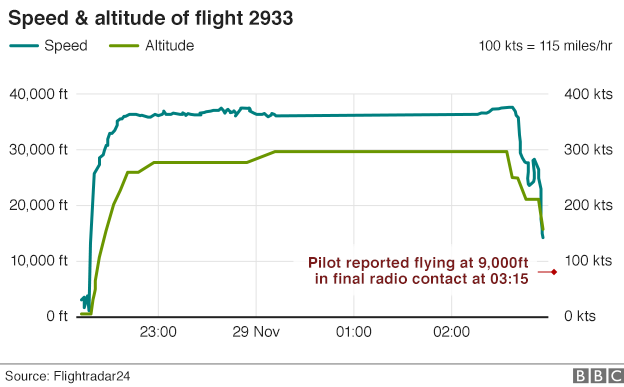
At around 22:15 on Monday (03:15 GMT on Tuesday), it crashed on the approach to Medellin.
Investigators say the plane did not have any fuel at the moment of impact.
That appeared to corroborate a leaked tape in which the pilot can be heard requesting permission to land owing to an electrical failure and lack of fuel.

The final call
Pilot: Lima-Mike-India 2933 is in total failure, total electrical failure and [without] fuel.
Tower: Runway is free. Expect rain on the surface Lima-Mike-India 933, firemen have been alerted.
Pilot: Vectors, miss. Tell me the vectors from the runway.
Tower: I can't find you on the radar. What is your direction now?
Pilot: Direction three six zero. Three six zero.
Tower: Turn left zero one zero and proceed to the Rio Negro localiser 1 mile ahead of VOR [combined radio navigation station]... I confirm left in the direction of three five zero.
Pilot: Left three five zero.
Tower: Yes, correct. You're at one mile to the Rio Negro localiser.
Tower: I don't have your altitude, Lima-Mike-India.
Pilot: 9,000ft, miss. Vectors, vectors.
Tower: You're 8.2 miles to the runway.
Pilot: Jesus.
Tower: What's your altitude now?

Freddy Bonilla, a civil aviation official in Colombia said the electrical fault could have been caused by lack of fuel.
Both flight recorders, which could provide essential information into what happened, have been recovered. But a full investigation into the crash is expected to take months.
Investigators will also look into the flight plan. Mr Bonilla said regulations stipulated that aircraft must have 30 minutes of extra fuel in reserve so as to be able to reach an alternative airport in an emergency.
A Bolivian air traffic controller, Celia Castedo, said she warned the pilot that there was barely enough fuel to reach the destination. Ms Castedo has accused her bosses of a cover-up - she is currently seeking asylum in Brazil.
A refuel stop in Bolivia had been planned. But the flight missed a stop in Cobija, in northern Bolivia, because the airport was closed at night, according to Gustavo Vargas, Lamia's director-general.
The pilot had mentioned the Colombian capital Bogota as a possible refuelling stop, but headed straight to Medellin.
A plane flying nearby had asked for priority in landing because of an emergency, minutes before the Lamia plane crashed.
As a result, according to reports, air traffic control told other approaching planes, including the Lamia flight, to fly holding patterns.
Who was on board?
The British Aerospace 146 short-haul plane was carrying 77 people.
Chapecoense were due to play in the final of the Copa Sudamericana, against Medellin team Atletico Nacional.
Footage shows the devastation following the crash near Medellin in Colombia
Three of the survivors are footballers: defenders Alan Ruschel and Helio Zemper Neto, as well as reserve goalkeeper Jakson Follmann.
Follmann's right leg has been amputated. Ruschel underwent spinal surgery, and Neto had severe trauma to his skull, thorax and lungs. They were all in intensive care.
The club's main goalkeeper, Marcos Danilo Padilha, was pulled alive from the wreckage but later died.
Two crew members - flight attendant Ximena Suarez and flight technician Erwin Tumiri - and journalist Rafael Henzel also survived.
Colombian aviation officials said there were 21 journalists on board, six of them from the Fox Sports Brazil channel and others from the Globo TV network.
Who are Chapecoense?
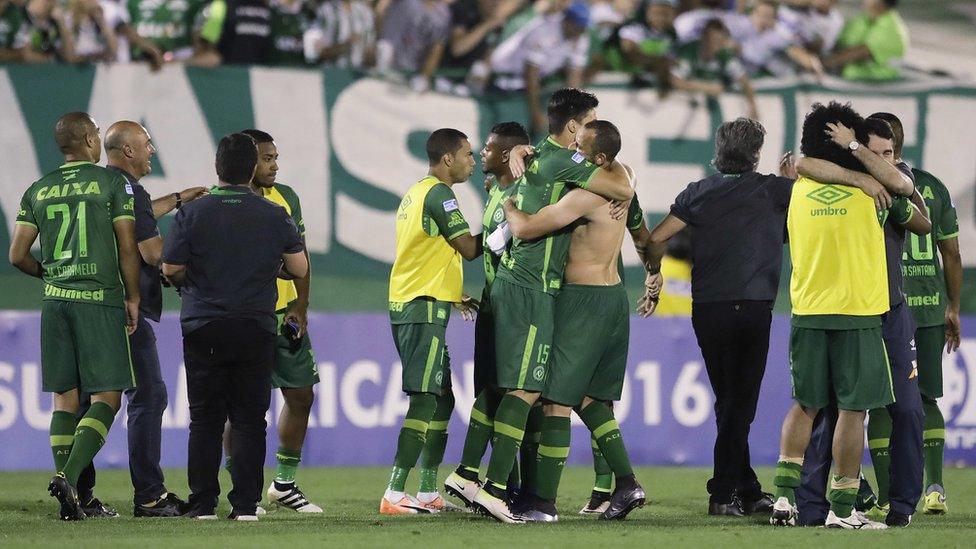
The Chapecoense players celebrate after beating Argentina's San Lorenzo - the Pope's team
Chapecoense are a small team from Chapeco, a southern city in an area not commonly associated with the big clubs of the Copa Sudamericana, South America's equivalent of the Europa League.
The team, founded in 1973, has been performing well this year, sitting in the middle of the table of the national championship.
Chapecoense were promoted to Brazil's top division, Serie A, for the first time in its history in 2014.
It is quite an achievement for a low-budget club with no star player.
Last week they were seen rejoicing after beating Argentina's Club Atletico San Lorenzo de Almagro, a major team whose supporters include Pope Francis.
What type of plane was it?

The Avro RJ85 plane used by the Brazilian soccer team Chapecoense
The Avro RJ85, a variation on the BAE 146 aircraft, is often used by carriers to service small city-based airports.
The four-engine plane was first used in 1999 and belonged to two other airlines before being sold to Lamia.
This is not the first recorded incident involving a BAE 146 model plane:
In 1991, a chartered LAN Chile plane overran a runway on its approach to Puerto Williams Airport in Chile, with 20 of the 73 people on board killed
In 2006, another BAE 146 operated by Atlantic Airways overshot the runway at Stord Airport in Norway. with four deaths, because of a braking failure.
Lamia, originally a Venezuelan operator but now based in Bolivia, requested permission from the Brazilian aviation agency Anac to transport the Chapecoense team on a charter flight from Brazil to Colombia.
Anac denied the request because Brazilian regulations state that only Brazilian or Colombian airlines can fly between the two countries.
The team then took a commercial flight from Sao Paulo in Brazil to Santa Cruz de la Sierra in Bolivia, before boarding the Lamia flight bound for Medellin.
- Published1 December 2016

- Published30 November 2016
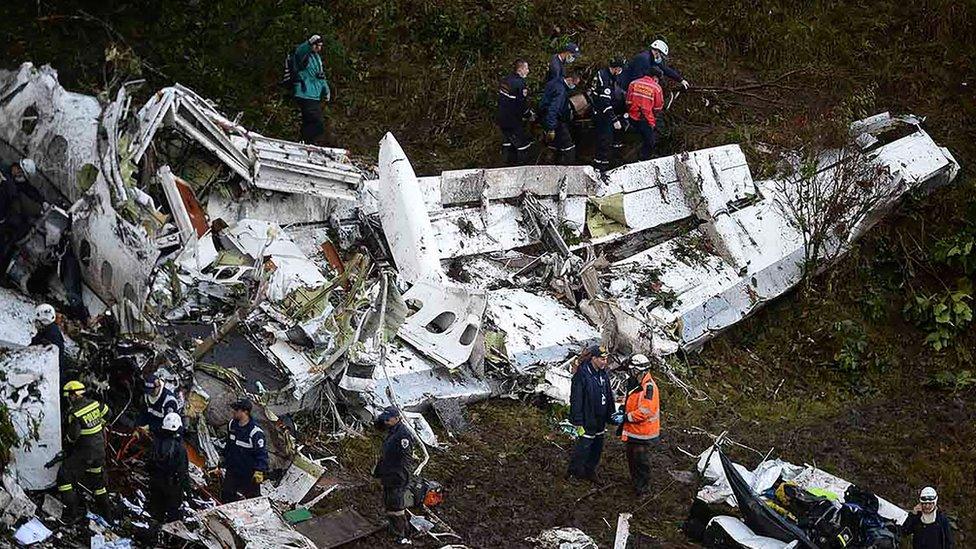
- Attribution
- Published29 November 2016

- Published29 November 2016
